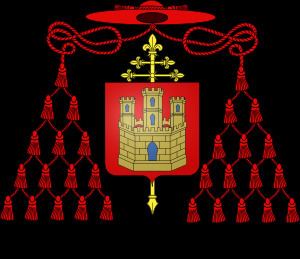 | ||
The House of Carrillo is a Spanish noble house that traces its origins from the ancient Kingdom of Castile. There are several branches that exist such as Carrillo de Albornoz, Carrillo de Mendoza, Carrillo de Figueroa, Carrillo de Toledo and Carrillo Tablas among others. There are also several variations in spelling of the surname Carrillo such as "Carillo". Records prove that both surnames are one and the same.
Contents
Name origins
Carrillo is a Spanish surname, and reference to the family dates back to the Kingdom of Castile in the thirteenth century. According to a folkloric family origin legend, two brothers sharing royal bloodline accidentally killed a favorite courtier of their King, which forced them to flee into hiding to avoid his rage (it is said that the brothers dueled with the courtier over the honor of a beautiful Spanish maiden). The brothers eventually arrived in Spain after being placed under the protection of Count Fernán González of Castile. (their country of origin is unknown). There they were so loyal to each other, they never left each other's side, and hence were called by the Castilians Carrillo, which is given several false etymologies: "loyal or devoted", implying that the brothers were very close one to another like the "carillon bells of the church towers", or comparing them to "two wheels on a cart". The brothers endeared themselves to the Castilians, and married two daughters of the Count. He gave them the titles of Count of Priego for the elder brother, and Marquis De La Guardia for the younger. All lines of the Carrillo family are said to branch from these two brothers. The name also appears in connection with an ancient Spanish legend concerning the Siete Infantes de Lara (Seven Princes of Lara).
The surname "Carrillo" is first found in Castile, Spain, in Burgos, Palencia, Soria, Logroño, Navarre, and Andalucia. Family members later went off to help in the conquest and establishment of colonies outside Spain, and included Cuba, Puerto Rico, Mexico, Venezuela, Costa Rica, Colombia, Chile, Philippines, Argentina, and the United States of America, particularly California.
Influence and service
The House of Carrillo frequently served the government through holding many offices and providing military leaders for Spain. Several prominent members of the house have been granted titles of nobility for services rendered to the state. The House of Carrillo has also produced three Catholic Cardinals, Cardinal Alonso de Carrillo Laso, Cardinal Alonso Carrillo de Albornoz and Cardinal Gil Alvarez Carrillo de Albornoz.
The most famous military leader produced by the House of Carrillo is José Carrillo de Albornoz, 1st Duke of Montemar who was Viceroy of Sicily. He victoriously lead the Spanish forces at the Battle of Bitonto. Because of his services, he was ennobled by King Philip V of Spain.
The Farce of Avila
Don Alfonso Carrillo, the Archbishop of Toledo, was said to have been the personification of intrigue. Jealous of the attention given to the Count Beltran de la Cueva, Carrillo headed the clique that went against King Enrique IV and was one of the people involved in the event known in history as the Farce of Avila. They later proceeded to take over the government by placing a dummy-King on the throne, proclaiming the Archbishop as Prince Alfonso. Carrillo was the main force in the matter and instigated the marriage of Prince Alfonso to Princess Isabel, later becoming the Princess’ spokesperson. But the tides soon turned against them and the Archbishop had to retreat from the affairs of court until his death.
Prominent members
Below are some of the members and descendants of the House of Carrillo:
